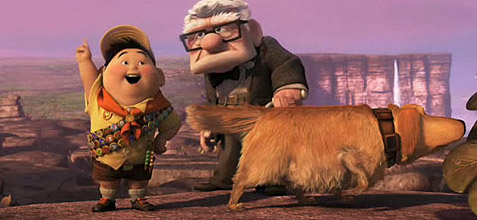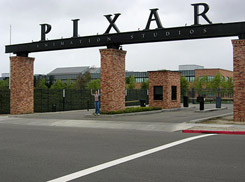
Interview date: 05/21/2009
Run date: 05/27/2009
Movies Home / Entertainment Channel / Bullz-Eye Home
If a Pixar movie has either made you cry or brought you to the edge of tears, odds are Pete Docter was involved. All of Pixar’s directors are mindful of making family-friendly entertainment, but Docter is all about the heart, and his latest effort “Up” raises the ante tenfold. Bullz-Eye caught up with Docter to ask him about the darkest days in Pixar’s history, the risks that come with making a 78-year-old the lead in your movie, and how he feels about the work that his fellow animators are producing. Surprise! He’s somewhat disappointed.
Bullz-Eye: Pleasure to talk to you, for starters. Thanks for taking the time to talk to us.
PD: Not at all.
BE: You’ll be happy to know that the first full-length movie I showed my son, who is now two, was “Monsters, Inc.”.
PD: Oh, wow.
BE: Yeah. Although now he’s all about [“Finding Nemo” and “WALL·E” director] Andrew Stanton.
PD: Oh, he wasn’t freaked out at all by “Monsters”?
BE: No, no, not at all.
PD: Good.
BE: So, your movie opened the Cannes Film Festival. That’s pretty cool.
PD: Yeah, that’s not something that happens every day. In fact, this is the first animated film to open the festival there in their 62-year run, so not bad; pretty cool.
BE: I saw the movie on Tuesday, and I’d just like to say…you bastard. I cried like a little girl during the opening sequence.
PD: (Laughs) Well, cool, that’s great. I mean, we sort of knew we had a lot of comedy and action stuff coming up later, so I don’t know about you, but films that really stick with me are ones that have some sort of heart to them, and emotional basis. That’s where we were going with that.
BE: Well, that’s definitely a theme within your work, because the last scene in “Monsters, Inc.” kills me as well.
PD: Oh, cool. I actually animated that scene myself. That was fun.
BE: “Up” is the first real Pixar movie that takes place within “our” world, as it were. Was that a conscious decision on the studio’s part to move away from like the fish world or the insect world?
PD: No, it was more just a sense of, “Okay, what have we not done?” Every time we approach a project, we want to make sure that we’re doing something new, that we haven’t covered this territory already. And in this case, there is just something to Bob Peterson and I – Bob is the head writer and co-director on the project – we were thinking there is something really appealing about a grouchy old guy, who is the “get off of my lawn,” keeps-your-baseballs kind of guy. Do you know what I mean?
BE: Yes.
PD: So we just started playing with that, and it did seem like it had a lot of comic potential, as well as great emotional appeal as well. So it wasn’t so much a desire to move away from anything, it was just move towards something different.

BE: Fair enough. Now tell me about approaching the 3D aspect of the movie? Was there a part of you that wanted nothing to do with it on general principle?
PD: Well, it was definitely…to me, I guess, whenever you come across new technology like this, it’s like, “Oh, this is a kind of cool new toy…how can we break it? What can we do with this?” Pixar had done a couple of 3D films before, one in ’89, “Knick Knack,” the short film. So it’s definitely something that everybody was intrigued by. And then we just started putting together a great team that tried to figure out what makes things work and when do things break. To me, the things that bug me about 3D, as cool as it is when things come out at you in to your face, I end up being very conscious of “Hey, I’m watching a movie with glasses on.” Do you know what I mean?
BE: Yes.
PD: So we made a conscious effort to try not to do that, to treat it more subtly. Almost like a window looking in, as opposed to coming out at you. And in that sense, it’s just more of a story coming to life. We can use it to emphasize certain scenes. When we want Carl to feel closed off and alone, we sort of squash the space. And then when he takes off, we really want to emphasize how grand something is, so you make it real dynamic and deep. So it just ended up being another tool in which to tell the stories.
BE: Give me your honest reaction when that report surfaced saying that a research group was questioning your movie’s viability because of its lack of merchandising potential.
PD: Well, I wasn’t sure to be offended or pleased, you know? Because just myself, I… and this is kind of our approach at Pixar in general, we don’t really think about marketing and merchandising. That’s not what makes a good movie. If you start with that…well, you know where that goes. You have to think about good storytelling and characters first. Then hopefully, the rest of that stuff will follow, some more than others. But if you don’t have a good film and strong characters, then you don’t have anything down the road.
BE: I read Robert Iger’s quote about the ‘check the box’ approach to filmmaking, and I literally pumped my fist in the air when I saw that.
PD: Yeah, he’s been great, and John Lasseter, it has always been their philosophy; both of them have been very clear about, “Just make a great movie and don’t worry about the other stuff. It will come.”
BE: Does Pixar have any house rules in terms of what they absolutely will not put into a movie?
PD: Not that I know of, no. I mean, we did early on in “Toy Story”; this was [made] as animation had been boxing itself off a little bit. Or at least that’s the way people were perceiving it. “It’s animated? Well, where do the princesses go, and where’s the ‘I Want’ song,” and all those things. So on “Toy Story,” we made a list of things that we did not want. We wanted to break free of any sort of genre that people were putting animation into. It’s a medium; you could do anything with it. You could do horror films, you could do whatever. Anything is possible. But now, as we go forward, I guess the only rule we have for ourselves is to try to make it unique and different from what we’ve done, so that you’re not traveling down a road that you’ve already been down.
BE: Well, what inspired that question was that before the screening of “Up,” they showed a trailer for the upcoming Disney movie about the spy gerbils or whatever. (Note: They’re guinea pigs, and the movie is called “G Force.”)
PD: Oh, yeah.
BE: It had two underwear jokes and two fart jokes in the span of three minutes. And I thought, “Pixar wouldn’t do that.”
 PD: Oh, I see. Every film is different, and every director is different. I guess it just depends on where you end up. I wouldn’t say that we are holier than that, or anything. We have our share of butt jokes and stuff. It just kind of depends on the taste of whoever is doing it, I guess.
PD: Oh, I see. Every film is different, and every director is different. I guess it just depends on where you end up. I wouldn’t say that we are holier than that, or anything. We have our share of butt jokes and stuff. It just kind of depends on the taste of whoever is doing it, I guess.
BE: I don’t expect a straight answer from this, but I have to ask: what do you think of the animated movies that the other studios are putting out? Admit it, don’t you want to slap a couple of them around? Because I know I do.
PD: Well, I mean, there are definitely films that come out that I don’t really have any desire to see. There are other films that come out and I go, “Yeah, I would never make that, but that is so cool.” I love it when you see films that are just totally different, that are coming out of a real different direction. I think “Coraline” does that. It’s just…again, not something that Pixar would do, but it’s very Henry Selick, and it approaches storytelling from a different angle. I love the Aardman films for that same reason. They just have such charm and appeal and they really keep the medium diverse. That’s what I think is the sign of a healthy industry, is when you have all these different choices and different approaches. There is no right or wrong with this stuff. It’s art; it’s not math. Some people love different things than what other people like. That’s the idea.
BE: That’s funny you mention “Coraline,” because I was going to ask you if you guys had considered granting Henry Selick the Brad Bird exemption clause to let him come in and do a movie for you.
PD: Yeah, I don’t know. I mean, that’s kind of outside of my purview, but the guy is a very talented designer and filmmaker. I hope he keeps making movies.
BE: This is your first directorial effort in eight years, and most Pixar movies, by my estimate, take anywhere from three to five years to put together. Was there a specific reason for the delay between movies, or was it just a matter of waiting your turn?
PD: Well, on this one, let’s see…I guess by the time I got done with “Monsters,” it was late ’02. It came out late ’01. And then I started in on a project that kind of didn’t go, that became “WALL·E.” Andrew [Stanton] took that on, and was able to make certain things work that I was having trouble with. And then I worked on “Howl’s Moving Castle,” the English translation of that. And then [there were] a couple of other projects that kind of sputtered for a little while and then finally caught fire, and that was in early ’04 on this one. So it just took whatever time it took. Longer than I would have wanted, for sure, but I got to do some interesting stuff in the interim.
BE: Were you as upset as I was when “WALL·E” didn’t win either of the Academy Awards for sound?
PD: Oh, yeah. I mean they really did such a stellar job, and it just seemed like it had a real chance to me. That was a bummer.
BE: Legend has it that every Pixar movie has hit a point where the people working on it think it’s awful and unfixable. Did “Up” hit a similar spot?
PD: Well, obviously we don’t think that it’s unfixable, or we would dump it. But “Up” had its most difficult time – now that it’s done I can look back on it – I think it was the early, early days. And getting back to your last question of why has it been so long [since my last directorial effort], you know, it just had trouble…I was really pushing for something more otherworldly and abstract. It just took us a while to figure out what elements we need to appeal to people, to move forward. So once we locked in on the old man and the floating house, that’s where we started hitting strides.
BE: Now a follow-up to that: which Pixar movie was, in your opinion, the most difficult one to “get on track”?
PD: Oh, let’s see…I guess that depends how you define difficult. “Toy Story” probably had the darkest hour, and the most chance of just sinking the company. I mean, there was a time, and I don’t remember what day of the week this was – we’ve referred to it as Black Monday – but where we had a screening of the film, and it was awful. Even we, now looking back at it, go, “Oh my gosh, that’s awful. The characters aren’t appealing, and I don’t want to watch these guys.” They threatened to shut the studio down and lay everybody off, and move everybody to L.A. to try to fix it. Luckily, the Pixar folks stood up for us and said, “Just give us another chance.” Basically, what we did in a very short amount of time, two or three weeks, John [Lasseter] was able to get it from them and say, “Let’s just make the movie that we want to make. We’re going to ignore all the notes that we’ve gotten and come on, let’s just do it.” We worked long nights, and everybody pulled together and did stuff all together. And we finally put something out that wasn’t the complete film, but was enough to get people back on board and say, “Oh, all right, these guys aren’t a bunch of insane people.”
BE: [SPOILER ALERT: If you haven’t seen the movie, continue reading at your own peril.] The Charles Muntz character, the brave explorer and Carl’s childhood idol that turns out to be less than heroic: I can’t help but think that was based on a personal experience of yours. Am I right?
PD: Not really.
BE: Meeting someone in Hollywood and realizing, “Oh my gosh, they’re not at all who I thought they would be.”
PD: Not really. It was more just a desire to twist expectation. I mean, I’ve definitely had experiences in my own life where I have built people up, kind of unfairly. One of my heroes was Jim Henson. I got to meet him and he was very nice, but he didn’t single me out and hire me on the spot, which is what I was expecting. So that was a bit disappointing. But more than that, [Charles Muntz] was just based on the idea of twisting expectation and kind of foiling what the audience…where they think this is going.
BE: Fair enough.
PD: But I’m curious, what about it, do you think, felt to you like it was from personal experience? What do you think led you to that?
BE: I can’t really put my finger on it. I don’t know your history well enough to say. I just didn’t know if you had run into some animation legend and had this really awkward, miserable experience like Carl has when meets Charles Muntz. It was pure conjecture on my part.
PD: I was just curious to know if there was something in there. It’s actually really cool that you thought that, just because we always try to make these feel as personal as we can. But unfortunately, there is no great story there. [END OF SPOILER ALERT]
BE: So what do you have planned next?
PD: Next for me is some time off, and then hopefully get back in there and do another film before another three, four years go by.
BE: Do you have any stories that you are sketching out right now?
PD: Yeah, I’ve got some ideas that are tumbling around back in my head, but nothing that I want to talk about at this point.
BE: Well, I will keep you on schedule. I appreciate you taking the time to talk with us.
PD: All right, thank you.
BE: I love the movie. Best of luck with it.
PD: Oh, thanks.
You can follow us on Twitter and Facebook for content updates. Also, sign up for our email list for weekly updates and check us out on Google+ as well.












